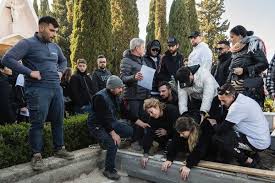Italy: The other Naples, not seen on Instagram

Naples: As tourists followed the smell of fried pizza, posed by white and blue murals of Diego Maradona on streets lined with dangling laundry, and marveled at the decadent beauty of Naples, an 18-year-old boy and 26-year-old twin sisters were killed as the makeshift fireworks factory where they worked blew up.
Their burned, mutilated bodies were found among the explosives and the cans of detergent they also bottled for a living in a house amid olive trees and orange groves near the ancient Roman citadel Herculaneum, outside Naples.
The deaths in November of the three young Neapolitans, who took the risky jobs for about 25 euros, or $26, a day because they could not find better ones, highlighted how, despite Naples’s recent hype and tourism boom, it remains a merciless city for many of its own young people.
“Naples is like a tomb,” said Adamo Dumbia, 38, after he shoveled dirt on the grave of Samuel Tafciu, his stepdaughter’s fiancé, who died in the blast. “It’s pretty from the outside, but you don’t want to see what is inside.”
ImageA building lies in rubble against the background of rolling peaks and partly cloudy skies.
Candles and flowers at the gravesite of Sara and Aurora Esposito. The women worked off the books making fireworks because they had no other options, a sister said.
Since the pandemic, Naples has become an Instagram sensation. Tourism has surged, especially among foreigners. Many of them were introduced to the city through the novels of Elena Ferrante. Hollywood actors have stopped there. The model Emily Ratajkowski posed for photos with a Napoli soccer jersey. Countless Instagram posts showcase older Neapolitans with leathery tans, tattooed chests, heavy makeup and crucifixes under the summer’s scorching sun. Charli XCX sang about such images in the song “Everything is Romantic.” It all has contributed to building a seductive image of Naples that has attracted flocks of millennials.
But if Naples’s gaudy decadence is hot on social media, the city is also experiencing a much more unromantic, enduring and crude degradation that is engulfing the youth from its poorer quarters.
Despite the cash brought in by tourism, the city has one of the highest rates of youth unemployment in Italy at 43 percent. Gun violence has flared again, and this fall, three teenagers were shot dead within 20 days. About a sixth of jobs in the region are off the books, and young Neapolitans are dropping out of school and leaving the city in record numbers.
Once again, Naples is something of an archetype of Italy. For a long time, its pizza, sun, dialect and mannerisms have been what many picture when they think about Italy. Now, Naples has also come to embody one of the country’s most painful paradoxes: so appealing to foreigners, so daunting for its own youths.
“Naples is the city with the most contradictions,” said Luca Bianchi, the managing director of Svimez, a research center focused on Italy’s south. “And these contradictions are exploding.”
Naples has come to embody one of Italy’s most painful paradoxes: so appealing to foreigners, so daunting for its own young people, who grapple with high unemployment.
Aurora and Sara Esposito, the inseparable twins who died in the fireworks explosion, grew up on the outskirts of Naples with a single mother. Videos filmed at their bathroom mirror and posted on Aurora’s TikTok profile show her with bleached hair and a wide smile with braces on her teeth, singing and dancing to Neapolitan songs.
Like many other teenagers in the area, the two girls had left school young; they were 14. They worked odd jobs, including as cleaners and at a bakery, but money was running short. Sometimes the twins went to bed without dinner, said Giusy Esposito, their older sister, and they were threatened with eviction from the apartment they shared with their mother and Aurora’s 5-year-old daughter.
When the twins found off-the-books jobs making fireworks, they accepted because they had no choice, Giusy Esposito said.
The twins’ employer — who was arrested and jailed after the explosion — had set them up in a house with no electricity in Ponticelli, an eastern Naples suburb, and he drove them to work every morning.
The twins had no experience handling incendiary substances, and the makeshift factory had no security systems, the police said. It didn’t even have a toilet; Giusy Esposito said Aurora had to urinate in a bucket.
The cemetery where the Esposito twins were buried. The women had no experience handling incendiary substances and the makeshift factory had no security systems, the police said.
With them worked Samuel Tafciu, 18, the son of Albanian immigrants. About a year and a half earlier, he had met Rosita Giorgetti, 17, a Neapolitan girl who also lived in Ponticelli, an area plagued by poverty and Camorra mob violence. Both Samuel and Rosita had left school at about 14.
In June, their daughter, Anna Chiara, was born. The three slept together in a single bed in an apartment they shared with Rosita’s mother, her partner and two of Rosita’s four siblings. Samuel had such an insatiable appetite he would eat pasta for breakfast. On weekends, he would take Rosita to a fun fair or a McDonald’s.
In July Samuel turned 18 and proposed to Rosita, giving her a ring with heart-shaped cut glass. Every week, Rosita’s mother said, he put aside 50 euros for their wedding.
But in late November Rosita clasped her hands on Samuel’s white coffin at a cemetery north of Naples as she whispered, “It’s not Samu, it’s not Samu.”
“I would have rather had him go steal,” Rosita said that afternoon.
“He could have gone to jail. But jail is easy. Now I can’t see him, I can’t touch him, I can’t talk to him,” she said. “All our dreams went up in flames with him.”
Messages outside the destroyed fireworks factory commemorate the three people who died in the explosion.
Three days after Samuel’s funeral, at a cemetery at the foot of the Mount Vesuvius volcano, Giusy Esposito slumped to the ground as attendants lowered her sisters’ white coffins into twin graves. Years ago, she had also lost her husband and her brother-in-law as they worked off the books, she said.
“Why do we have to love people to have them torn away from us?” she asked. “Why do we have to live this way?”
Her uncle, Rosario Esposito, looked on. “This is how you live in Naples,” he said.
His son, 21, is planning to move to Sweden, he added. “He cannot also end up like this,” he said, pointing at the graves.
The main reason for the prevalence of illegal work, experts who study the region say, is persistent high unemployment and low education levels, especially among young people, giving employers huge leverage.
A failed experiment with industrialization, poor political administration and the pervasive presence of the Camorra mob have hampered the economy, and many of the available positions are low-level service jobs, the experts said.
Now tourism is transforming the city center, with the dark, damp “bassi” or ground-floor flats turning into short-term rentals. While some people are finding off-the-books employment as waiters or tour guides, experts say tourism is failing to bring a substantial increase in higher wage jobs.
A waiter walks in Piazza Mercato, an area of Naples that has recently seen a rise in youth violence.
Crimes involving guns and other weapons are rising among Naples’s disenfranchised youth, according to the police, and Italy’s interior minister recently announced a special operation to disarm the city.
But all of this rarely makes it into the visitors’ social media feeds.
Instagram and TikTok, said Ciro Pellegrino, the head of the Naples section for the news website Fanpage, are key to Naples’s allure, because they allow for its flaws to be left out of the frame.
“If you narrow down your field of view and only show chunks of the city,” he said, “there are parts of Naples that are extremely Instagrammable.”
On the Neapolitan seafront, marked by luxury hotels, Antonio Maimone tended public gardens featuring palm trees and giant cactuses in full view of the Mergellina promenade, a nightlife hot spot.
There, last year, his 18-year-old son, Francesco Pio Maimone, was shot dead by a stray bullet that hit him in his heart. A 20-year-old man was charged with murder. Both came from marginalized areas of Naples.
When the bullet hit him, Francesco Pio, who had dropped out of school at about 16 and worked part time washing trash bins, had just finished training as a pizza maker.
“Too often the youth in Naples only faces few choices: drugs, dealing or shooting,” Mr. Maimone said.
“For as much as Naples is beautiful,” he said, “it is also so ugly.”
By the Naples train station, there is a huge mural of Maradona, the Argentine soccer legend who led Napoli to championships and who has become one of the city’s biggest folk heroes, and a symbol of hope and Neapolitan pride. Small, inside Maradona’s iris, an artist has painted a portrait of Francesco Pio.





